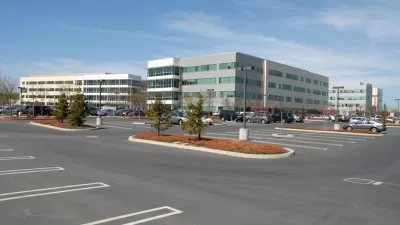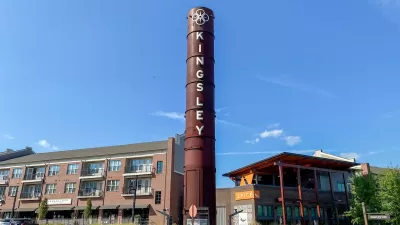With more and more employers downsizing and moving to areas with more urban amenities, large suburban office parks offer an opportunity for increased density and mixed-use development.

Writing in The New York Times, Emily Badger describes the plight of a fading American typology: the suburban office park. “Today suburban office parks have drawn far less attention than downtown offices that are also threatened by remote work. But their decline reflects in some ways a more sweeping and permanent judgment — of once-dominant ideas about where Americans work, how the office should look, and what the suburbs should be.”
According to Badger, “Far from downtowns, there is a different kind of emptiness in suburban settings that were already isolated and lightly populated by design.” While some office parks will likely be modernized and used as offices again, “Other sites will have to become something fundamentally different: schools, senior living centers, apartment complexes, public parks, warehouses.” According to an estimate by commercial real estate firm Jones Lang LaSalle, “57 percent of suburban office space nationwide is so old as to be functionally obsolete.”
However, their massive footprints offer the opportunity for redevelopment with a variety of uses and amenities. “Amid a nationwide housing crisis, many obsolete office parks could be ideal sites for denser housing.” As Badger points out, “Multifamily housing is expensive to build, but the land now being used for suburban parking lots is cheap, so the economics can work out (if the politics do).” To this end, cities and counties must be open to zoning reforms that allow for adaptive reuse of office parks and promote mixed-use development on these sites.
FULL STORY: Lonely Last Days in the Suburban Office Park

Alabama: Trump Terminates Settlements for Black Communities Harmed By Raw Sewage
Trump deemed the landmark civil rights agreement “illegal DEI and environmental justice policy.”

Planetizen Federal Action Tracker
A weekly monitor of how Trump’s orders and actions are impacting planners and planning in America.

How Atlanta Built 7,000 Housing Units in 3 Years
The city’s comprehensive, neighborhood-focused housing strategy focuses on identifying properties and land that can be repurposed for housing and encouraging development in underserved neighborhoods.

In Both Crashes and Crime, Public Transportation is Far Safer than Driving
Contrary to popular assumptions, public transportation has far lower crash and crime rates than automobile travel. For safer communities, improve and encourage transit travel.

Report: Zoning Reforms Should Complement Nashville’s Ambitious Transit Plan
Without reform, restrictive zoning codes will limit the impact of the city’s planned transit expansion and could exclude some of the residents who depend on transit the most.

Judge Orders Release of Frozen IRA, IIJA Funding
The decision is a victory for environmental groups who charged that freezing funds for critical infrastructure and disaster response programs caused “real and irreparable harm” to communities.
Urban Design for Planners 1: Software Tools
This six-course series explores essential urban design concepts using open source software and equips planners with the tools they need to participate fully in the urban design process.
Planning for Universal Design
Learn the tools for implementing Universal Design in planning regulations.
Jessamine County Fiscal Court
Caltrans
Institute for Housing and Urban Development Studies (IHS)
City of Grandview
Harvard GSD Executive Education
Toledo-Lucas County Plan Commissions
Salt Lake City
NYU Wagner Graduate School of Public Service





























